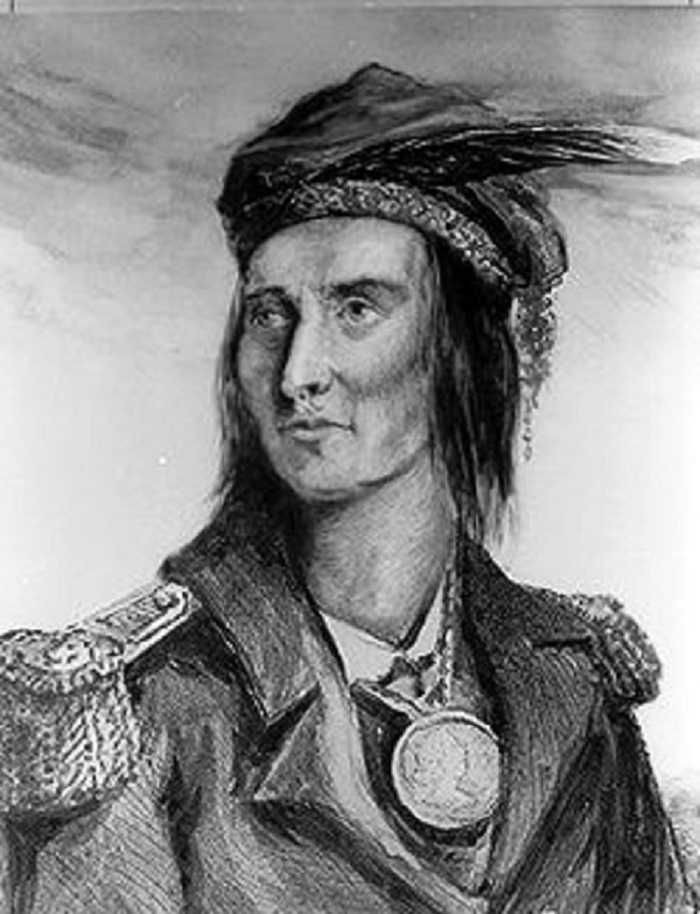
Tecumseh (1768-1813) was a Shawnee warrior, chief, and skilled diplomat who sought to unite Native American tribes to resist the westward expansion of white settlers in the early 19th century. Known for his strong leadership, vision, and oratory skills, Tecumseh's efforts to form a Native American confederacy left a lasting impact on the history of the United States.
Early Life:
Tecumseh was born in 1768 near present-day Springfield, Ohio, in a village along the Scioto River. He grew up during a period of immense upheaval and violence between European settlers and Native Americans, which shaped his views on the need for unified resistance. His father, Puckeshinwau, was a minor Shawnee chief who was killed in the Battle of Point Pleasant in 1774.
As a young warrior, Tecumseh fought in numerous battles against the encroachment of white settlers on Native American lands. His experiences in these battles solidified his commitment to defending his people's way of life.
Forming a Confederacy:
In the late 18th and early 19th centuries, Tecumseh and his brother Tenskwatawa, known as the Prophet, sought to establish a united Native American front to oppose the expansion of the United States. They envisioned a confederacy that would encompass multiple tribes and span a vast territory, providing strength in numbers and a unified political front.
The brothers' message resonated with many Native Americans, who were disillusioned by the rapid loss of their lands and the erosion of their cultural heritage. Tecumseh traveled extensively throughout the region, from the Great Lakes to the Gulf of Mexico, seeking to rally tribes to his cause.
War of 1812 and Death:
When the War of 1812 broke out between the United States and Britain, Tecumseh saw an opportunity to form an alliance with the British in order to bolster his confederacy. He led Native American forces alongside British troops in several key battles, including the Siege of Detroit and the Battle of Frenchtown.
However, the alliance was ultimately unsuccessful, and Tecumseh's forces suffered a significant defeat at the Battle of the Thames on October 5, 1813. Tecumseh himself was killed in the battle, and his death marked the end of the Native American confederacy he had sought to build.
Legacy:
Tecumseh's vision of a united Native American confederacy ultimately failed, but his leadership and efforts left an indelible mark on American history. Today, he is remembered as a symbol of resistance against the encroachment of white settlers on Native American lands and for his tireless pursuit of a unified Native American front.
His legacy has been commemorated in various ways, including numerous statues, monuments, and schools named in his honor. Tecumseh's determination and commitment to his people's cause continue to inspire and serve as a reminder of the complex history of the United States.
What Battles was Tecumseh (1768-1813) involved in?
Tecumseh was a Shawnee warrior and chief who fought in numerous battles throughout his life, both in the context of resisting American westward expansion and during the War of 1812. Some of the notable battles and conflicts he was involved in include:
-
Battle of Fallen Timbers (1794): Tecumseh participated in this battle as a member of the Western Confederacy, a coalition of Native American tribes fighting against the United States. The battle took place near present-day Maumee, Ohio, and resulted in a defeat for the Native American forces. The subsequent Treaty of Greenville led to significant land cessions by the tribes to the United States.
-
Siege of Fort Meigs (1813): During the War of 1812, Tecumseh allied with the British and participated in the Siege of Fort Meigs, located in modern-day Perrysburg, Ohio. Although the siege did not result in the capture of the fort, it showcased Tecumseh's strategic abilities and his capacity for cooperation with the British forces.
-
Siege of Detroit (1812): Tecumseh played a significant role in the Siege of Detroit, a battle in which British forces, led by General Isaac Brock, and Native American forces, led by Tecumseh, captured the city of Detroit from the United States. Tecumseh's tactics and skillful use of deception contributed to the success of this campaign.
-
Battle of Frenchtown (1813): Also known as the River Raisin Massacre, the Battle of Frenchtown was another engagement during the War of 1812 in which Tecumseh and his Native American allies fought alongside British forces. The battle took place near modern-day Monroe, Michigan, and resulted in a decisive British and Native American victory.
-
Battle of the Thames (1813): This battle, also known as the Battle of Moraviantown, was a pivotal moment in both the War of 1812 and Tecumseh's life. It took place near modern-day Chatham, Ontario. Despite Tecumseh's efforts, the Native American and British forces were defeated by the American army, led by General William Henry Harrison. Tecumseh was killed in the battle, marking the end of his campaign to create a unified Native American confederacy.
While the previous response mentioned some of the major battles Tecumseh was involved in, he also took part in smaller skirmishes and confrontations as he sought to defend Native American lands and resist westward expansion. Here are a few more conflicts that Tecumseh participated in:
-
Battle of Point Pleasant (1774): Though Tecumseh was still very young (only around six years old) at the time of this battle, his father Puckeshinwau was killed during the conflict. This event had a significant impact on Tecumseh, likely influencing his later endeavors as a warrior and leader.
-
Northwest Indian War (1785-1795): Tecumseh fought in several engagements during this conflict between a confederation of Native American tribes and the United States. The war, also known as Little Turtle's War, involved a series of battles and raids throughout the Old Northwest Territory. Though Tecumseh's specific role in these skirmishes is not well-documented, he was an active participant in the broader struggle against American expansion in the region.
-
Tippecanoe Campaign (1811): As tensions rose between Native American tribes and American settlers in the Indiana Territory, Governor William Henry Harrison launched an offensive against Tecumseh's brother, Tenskwatawa (the Prophet), at Prophetstown. Although Tecumseh was not present for the Battle of Tippecanoe itself, he had been actively recruiting tribes for his confederacy and was a key figure in the lead-up to the conflict. The defeat of Tenskwatawa's forces at Tippecanoe weakened Tecumseh's confederation and led to his decision to ally with the British during the War of 1812.
-
Battle of Brownstown (1812): This skirmish occurred during the early stages of the War of 1812 and involved Tecumseh's forces ambushing a detachment of American soldiers near the village of Brownstown, located south of Detroit. The Americans were forced to retreat, resulting in a victory for Tecumseh and his allies.
___________________________________________________
"Will we let ourselves be destroyed in our turn without a struggle, give up our homes, our country bequeathed to us by the Great Spirit, the graves of our dead and everything that is dear and sacred to us? I know you will cry with me, 'Never! Never!'" - Chief Tecumseh, Shawnee
_____
Tecumseh (pron.: /tɛˈkʌmsə/; March 1768 – October 5, 1813) was a Native American leader of the Shawnee and a large tribal confederacy (known as Tecumseh's Confederacy) which opposed the United States during Tecumseh's War and the War of 1812. Tecumseh has become an iconic folk hero in American, Aboriginal and Canadian history.
Tecumseh grew up in the Ohio Country during the American Revolutionary War and the Northwest Indian War, where he was constantly exposed to warfare. With Americans continuing to encroach on Indian territory after the British ceded the Ohio Valley to the new United States in 1783, the Shawnee moved farther northwest. In 1808, they settled Prophetstown in present-day Indiana. With a vision of establishing an independent American Indian nation east of the Mississippi under British protection, Tecumseh worked to recruit additional tribes to the confederacy from the southern United States.
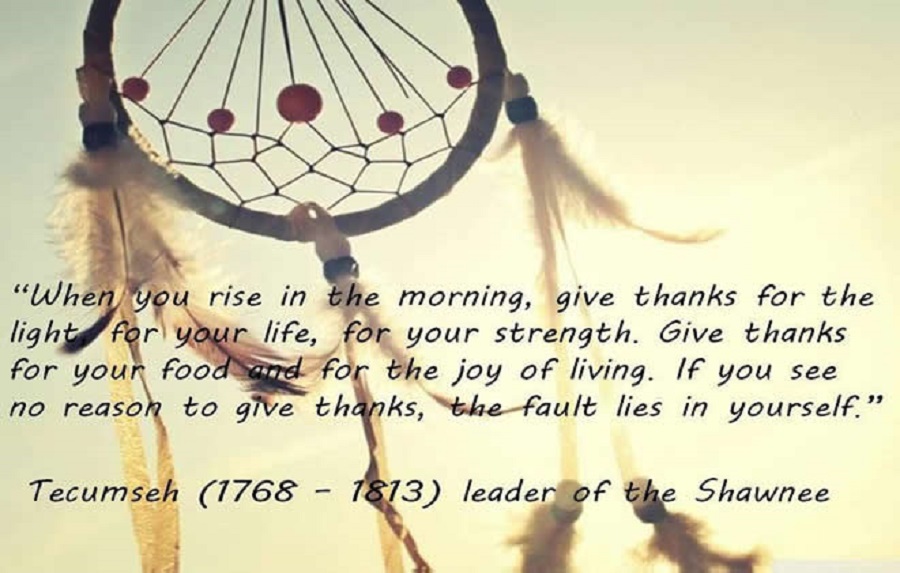 During the War of 1812, Tecumseh's confederacy allied with the British in The Canadas (the collective name for the colonies of Upper Canada and Lower Canada), and helped in the capture of Fort Detroit. American forces killed Tecumseh in the Battle of the Thames, in October 1813. His confederation fell apart, the British deserted their Indian allies at the peace conference that ended the War of 1812, the dream of an independent Indian state in the Midwest vanished, and American settlers took possession of all the territory south of the Great Lakes, driving the Indians west or into reservations.
During the War of 1812, Tecumseh's confederacy allied with the British in The Canadas (the collective name for the colonies of Upper Canada and Lower Canada), and helped in the capture of Fort Detroit. American forces killed Tecumseh in the Battle of the Thames, in October 1813. His confederation fell apart, the British deserted their Indian allies at the peace conference that ended the War of 1812, the dream of an independent Indian state in the Midwest vanished, and American settlers took possession of all the territory south of the Great Lakes, driving the Indians west or into reservations.
http://en.wikipedia.org/wiki/Tecumseh
"Sing your death song and die like a hero going home.” -- Chief Tecumseh, Shawnee
"Where today are the Pequot? Where are the Narragansett, the Mohican, the Pokanoket, and many other once powerful tribes of our people? They have vanished before the avarice and the oppression of the White Man, as snow before a summer sun.” - Chief Tecumseh, Shawnee
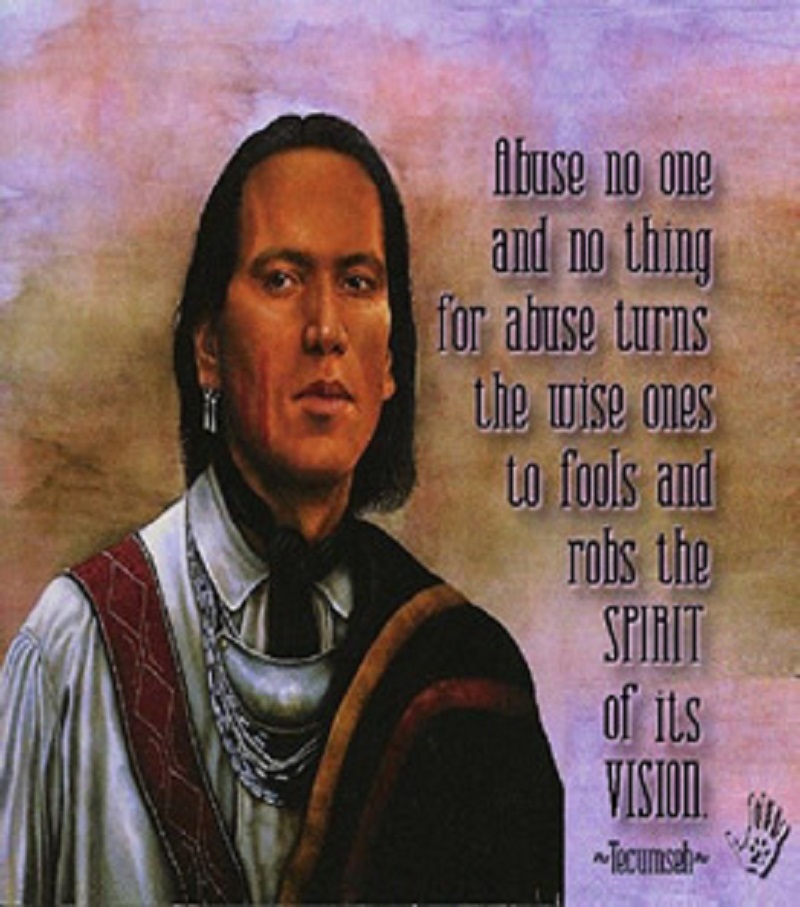 Tecumseh 1811
Tecumseh 1811
"The Great spirit gave this great Island to his red children. He placed the white children on the other side of the big water. They were not content with their own. They came to take ours from us. They have driven us from the seas to the lakes. We can go no further. My brother I do not see how we can remain at peace with you." He spoke these words to William Harrison. When he refused to sign his treaty. After this meeting Tecumseh rallied all natives to become one force. One people one fire. It has only taken us 202 years to try and become one again. Idle no more, maybe this time we will listen.
Tecumseh Shawnee Chief
1768-1813),Shawnee political leader and war chief. Born at Old Piqua, on the Mad River in western Ohio, Tecumseh grew to manhood amid the border warfare that ravaged the Ohio Valley during the last quarter of the eighteenth century. In 1774, his father, Puckeshinwa, was killed at the Battle of Point Pleasant, and in 1779 his mother, Methoataske, accompanied those Shawnees who migrated to Missouri. Raised by an older sister, Tecumpease, he accompanied an older brother, Chiksika, on a series of raids against frontier settlements in Kentucky and Tennessee in the late 1780s. He did not participate in the defeat of Gen. Josiah Harmar (1790), but led a scouting party that monitored Gen. Arthur St. Clair's advance (1791) and fought at Fort Recovery and Fallen Timbers (1794). Embittered by the Indian defeat, he did not attend the subsequent negotiations and refused to sign the Treaty of Greenville (1795).
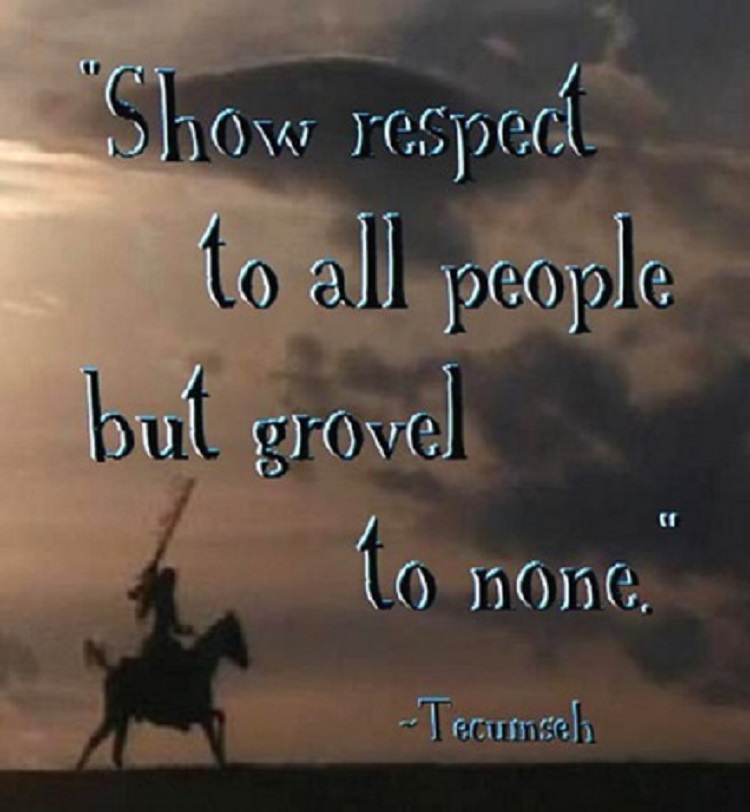 By 1800 Tecumseh had emerged as a prominent war chief. He led a band of militant, younger warriors and their families located at a village on the White River in east-central Indiana. There in 1805 Lalawethika, one of Tecumseh's younger brothers, experienced a series of visions that transformed him into a prominent religious leader. Taking the name Tenskwatawa, or 'The Open Door,' the new Shawnee Prophet began to preach a nativistic revitalization that seemed to offer the Indians a religious deliverance from their problems.
By 1800 Tecumseh had emerged as a prominent war chief. He led a band of militant, younger warriors and their families located at a village on the White River in east-central Indiana. There in 1805 Lalawethika, one of Tecumseh's younger brothers, experienced a series of visions that transformed him into a prominent religious leader. Taking the name Tenskwatawa, or 'The Open Door,' the new Shawnee Prophet began to preach a nativistic revitalization that seemed to offer the Indians a religious deliverance from their problems.
Tecumseh was born about 1768 near present-day Oldtowm. Ohio. He was raised from birth to make war on the encroaching whites by his mother, Methoataske, whose husband, the Shawnee Puckeshinwa, was killed in cold blood by settlers when Tecumseh was a boy. Tecumseh and his mother found him dying. As he watched his father die, Tecumseh vowed to become like " a fire spreading over the hill and valley, consuming the race of dark souls." A few years later, Tecumseh's hatred for the whites was compounded by the murder of CORNSTALK, a Shawnee chief who had been a mentor to the young man.
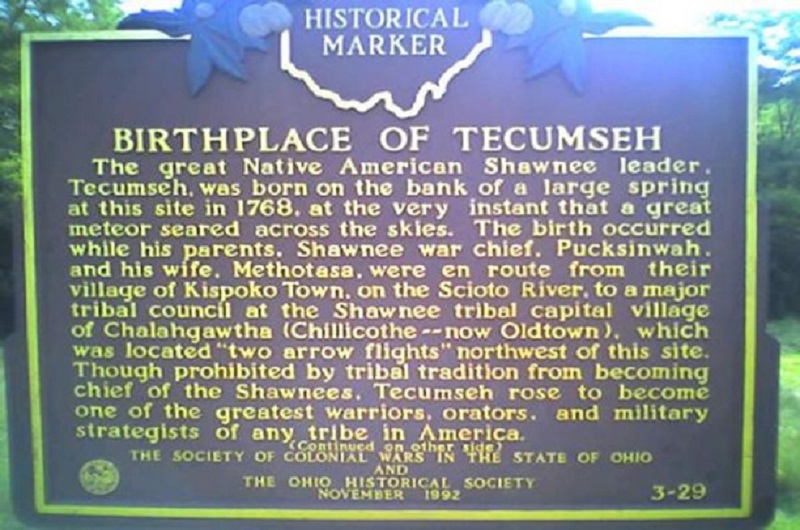 As Euro-American settlement began to explode accross the Appalachians into the Ohio Valley and Great Lakes shortly after 1790, Native resistance expressed itself in attempts at confederation along lines of mutual interest. A confederation that included elements of the Shawnees, Delawares, Wyandots, Miamis, and Ottawas told the United States in 1790 that settlers were not to transgress beyond the Ohio River. Thousands of settlers were surging into the area, ignoring governmental edicts from both sides. The settlers, who were squatters in the Indians' eyes, sought military help after members of the Native confederacy began attacking their settlements. Military expeditions were sent into the Ohio country during 1790 and 1792, but the Native confederacy remained unbowed and unmoved. In 1794, a force under the command of General "Mad Anthony" Wayne defeated the confederacy's warriors at Fallen Timbers ( a battle in which a young Tecumseh fought). In 1795, most of present-day Ohio and parts of Indiana were surrendered at the Treaty of Greenville.
As Euro-American settlement began to explode accross the Appalachians into the Ohio Valley and Great Lakes shortly after 1790, Native resistance expressed itself in attempts at confederation along lines of mutual interest. A confederation that included elements of the Shawnees, Delawares, Wyandots, Miamis, and Ottawas told the United States in 1790 that settlers were not to transgress beyond the Ohio River. Thousands of settlers were surging into the area, ignoring governmental edicts from both sides. The settlers, who were squatters in the Indians' eyes, sought military help after members of the Native confederacy began attacking their settlements. Military expeditions were sent into the Ohio country during 1790 and 1792, but the Native confederacy remained unbowed and unmoved. In 1794, a force under the command of General "Mad Anthony" Wayne defeated the confederacy's warriors at Fallen Timbers ( a battle in which a young Tecumseh fought). In 1795, most of present-day Ohio and parts of Indiana were surrendered at the Treaty of Greenville.
Native resistance surged again shortly after the turn of the century under the aegis of Tecumseh. As he came of age after the American Revolution, his influence grew rapidly not only because of his acumen as a statesman and a warrior, but because he forbade torture of prisoners. Both settlers and his Native allies trusted Tecumseh. By the turn of the century, as the number of settlers grew, Tecumseh beagn to assemble the Shawnees, Delawares, Ottawas, Ojibwas, Kickapoos, and Wyandots into a confederation with the aim of establishing a permanent Native state that would act as a buffer zone between the United States to the east and English Canada to the north. One white observer recalled Tecumseh as a commanding speaker. His voice was said to have "resounded over the multitude...his words like a succesion of thunderbolts." He advanced the doctrine that no single Native nation could sell its land without the consent of the entire confederacy that he was building. Rallying Native allies with an appeal for alliance about 1805, Tecumseh said, "Let us unite as brothers, as sons of one Mother Earth...Sell our land? Why not sell the air... Land cannot be sold." He tried to unite the southern tribes by appealing to history.
 Terretorial governor William Henry Harrison (who would later popularize his coming battle with Tecumseh at Tippecanoe in a succesful campaign for the presicency with the campaign slogan "Tippecanoe and Tyler Too") tried to undermine the growing strength of Tecumseh's Indian union by negotiating treaties of cession with individual tribes. Since only a portion of each tribe or nation's warriors elected to follow Tecumseh, Harrison found it easy enough to find "treaty Indians" among those who did not elect to fight. By 1811, Harrison negotiated at least fifteen treaties, all of which Tecumseh repudiated. Harrison's wariness of Tecumseh's power sprang from a deep respect for him "The implicit obedience and respect which the followers of Tecumseh pay to him is really astonishing and more than any other circumstances bespeaks him as one of those uncommon geniuses, which spring up occasionally to produce revolutions and to overturn the established order of things. If it were not for the vicinity of the United States, he would, perhaps, be the founder of an Empire that would rival in glory Mexico or Peru. No difficulties deter him". For his part, Tecumseh was particularly galled by the fact that Harrison had chosen as his territorial capital the village of Chillicothe, the same site (with the same name) as the Shawnees' former principal settlement. At one treaty council, Tecumseh refused to meet Harrison's terms. Finding himself seated next to Harrison on a bench, Tecumseh slowly but aggressively pushed him off its edge then told Harrison that that was what was happening to his people. During his last conference with Tecumseh, Harrison bid the chief to take a chair. "Your father requests you take a chair," an interpreter told Tecumseh, to which the chief replied, "My father! The sun is my father and the earth is my mother. I will repose upon her bosom." He then sat crosslegged on the ground.
Terretorial governor William Henry Harrison (who would later popularize his coming battle with Tecumseh at Tippecanoe in a succesful campaign for the presicency with the campaign slogan "Tippecanoe and Tyler Too") tried to undermine the growing strength of Tecumseh's Indian union by negotiating treaties of cession with individual tribes. Since only a portion of each tribe or nation's warriors elected to follow Tecumseh, Harrison found it easy enough to find "treaty Indians" among those who did not elect to fight. By 1811, Harrison negotiated at least fifteen treaties, all of which Tecumseh repudiated. Harrison's wariness of Tecumseh's power sprang from a deep respect for him "The implicit obedience and respect which the followers of Tecumseh pay to him is really astonishing and more than any other circumstances bespeaks him as one of those uncommon geniuses, which spring up occasionally to produce revolutions and to overturn the established order of things. If it were not for the vicinity of the United States, he would, perhaps, be the founder of an Empire that would rival in glory Mexico or Peru. No difficulties deter him". For his part, Tecumseh was particularly galled by the fact that Harrison had chosen as his territorial capital the village of Chillicothe, the same site (with the same name) as the Shawnees' former principal settlement. At one treaty council, Tecumseh refused to meet Harrison's terms. Finding himself seated next to Harrison on a bench, Tecumseh slowly but aggressively pushed him off its edge then told Harrison that that was what was happening to his people. During his last conference with Tecumseh, Harrison bid the chief to take a chair. "Your father requests you take a chair," an interpreter told Tecumseh, to which the chief replied, "My father! The sun is my father and the earth is my mother. I will repose upon her bosom." He then sat crosslegged on the ground.
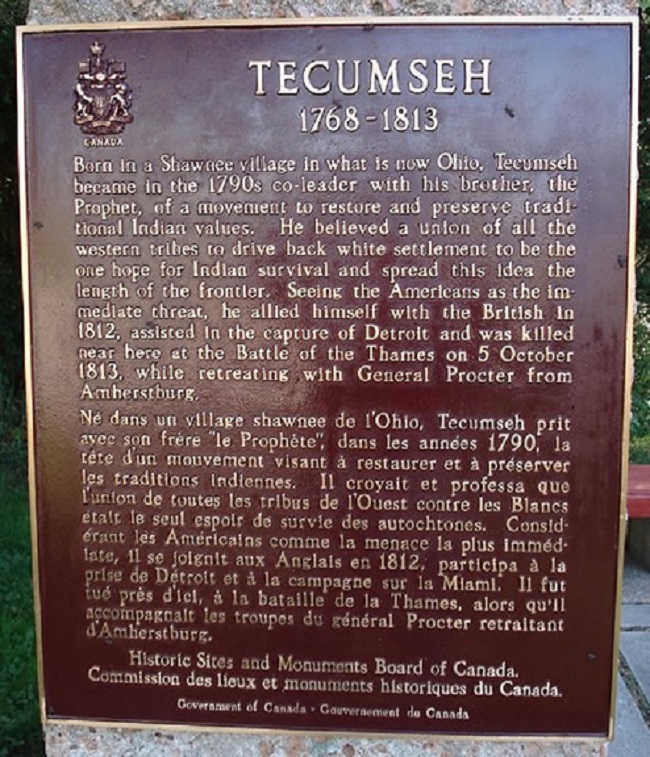 Tecumseh was also angry over Harrison's treaty of September 30, 1809, with the Delaware, Potawatomi, Miami, Kickapoo, Wea, and Eeel River peoples. For $8,200 in cash and $2,350 in annuties, Harrison had laid claim for the United Staes to roughly three million acres of rich hunting land along the the Wabash River, in the heart of the area in which Tecumseh wished to erect his Native confederacy. When Tecumseh and his brother , also a Shawnee war chief, complained to Harrison that the treaty terms were unfair, Harrison at first rebuked Tecumseh by saying that the Shawnees had not even been part of the treaty. The implicit refusal to recognize Tecumseh's alliance angered the Indians even more. Realizing that Tecumseh's influence made it politic for him to do so, Harrison agreed to meet with him. At a meeting on August 12, 1810, each side drew up several hundred battle-ready warriors and soldiers. Harrison agreed to relay Tecumseh's complaints to the president, and Tecumseh said that his warriors would join the Americans against the British if Harrison would annul the treaty. Nothing came of Harrison's promises, and in 1811, bands of warriors allied with Tecumseh began ranging out of the settlement of Tippecanoe to terrorize nearby farmsteads and small backwoods settlements. Harrison said he would wipe out Tippecanoe if the raids did not stop; Tecumseh said they would stop when the land signed away under the 1810 treaty was returned. Tecumseh then journeyed southward to bring the Creeks, Chicksaws, and Choctaws into his alliance. He carried the message that he had used to recruit other allies.
Tecumseh was also angry over Harrison's treaty of September 30, 1809, with the Delaware, Potawatomi, Miami, Kickapoo, Wea, and Eeel River peoples. For $8,200 in cash and $2,350 in annuties, Harrison had laid claim for the United Staes to roughly three million acres of rich hunting land along the the Wabash River, in the heart of the area in which Tecumseh wished to erect his Native confederacy. When Tecumseh and his brother , also a Shawnee war chief, complained to Harrison that the treaty terms were unfair, Harrison at first rebuked Tecumseh by saying that the Shawnees had not even been part of the treaty. The implicit refusal to recognize Tecumseh's alliance angered the Indians even more. Realizing that Tecumseh's influence made it politic for him to do so, Harrison agreed to meet with him. At a meeting on August 12, 1810, each side drew up several hundred battle-ready warriors and soldiers. Harrison agreed to relay Tecumseh's complaints to the president, and Tecumseh said that his warriors would join the Americans against the British if Harrison would annul the treaty. Nothing came of Harrison's promises, and in 1811, bands of warriors allied with Tecumseh began ranging out of the settlement of Tippecanoe to terrorize nearby farmsteads and small backwoods settlements. Harrison said he would wipe out Tippecanoe if the raids did not stop; Tecumseh said they would stop when the land signed away under the 1810 treaty was returned. Tecumseh then journeyed southward to bring the Creeks, Chicksaws, and Choctaws into his alliance. He carried the message that he had used to recruit other allies.
For the most part the trip failed to bring new allies. During this time, the command of the existing alliance fell to Tecumseh's brother TENSKWATAWA, who was called the Prophet. On September 26, 1811, Harrison decamped at Vincennes with more than nine hundred men, two-thirds of them Indian allies. He built a fort and named it after himself on the present-day site of Terre Haute, Indiana. Harrison then sent two Miamis to the Prophet to demand the return of property Harrison alleged had been stolen in the raids, along with the surrender of Indians he accused of murder. The Miamis did not return to Harrison's camp. The governor's army marched to within sight of Tippecanoe and met with Tenkswatawa, who invited them to make camp, relax, and negotiate. Instead, Harrison's forces set up in battle configurations, and the Prophet's warriors readied an attack. Within two hours of pitched battle, Harrison's forces routed the Indians and burned the village of Tippecanoe as Tenskwatawa's forces scattered into the woods.
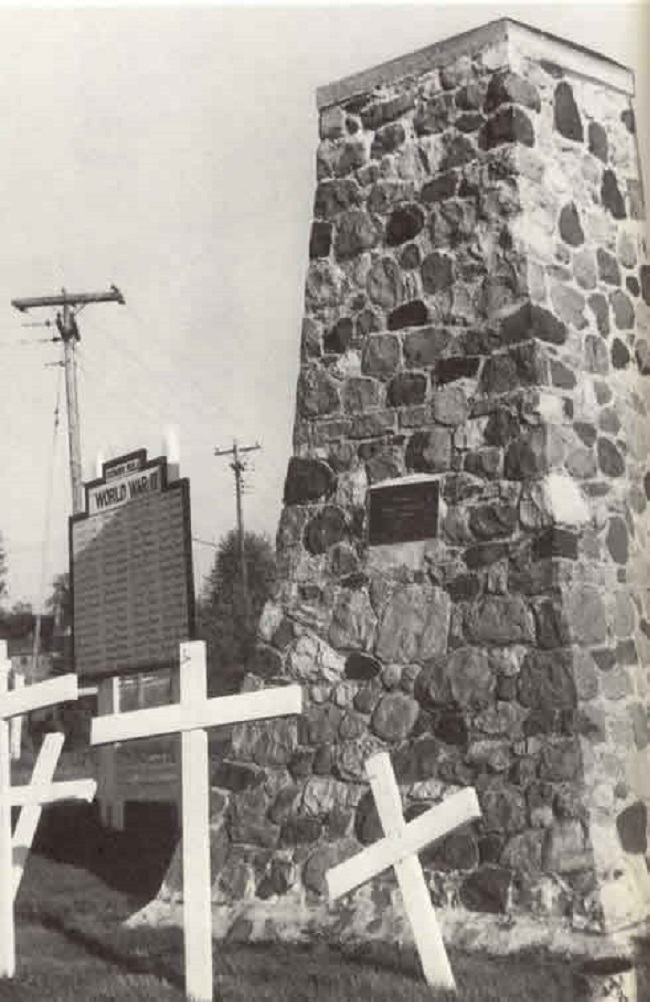 Returning to the devastation from his travels, Tecumseh fled to British Canada, where, during the war of 1812, he was put in command of a force of whites and Indians as a British brigadier general. During the battle in Ontario (Canada), Tecumseh was killed on October 5, 1813. After it, some of the Kentucky militia who had taken part found a body they thought was Tecumseh's and cut strips from it for souvenirs. (His warriors, who had dispersed in panic when Tecumseh died, said later that they had taken his body with them.) Having commited twenty thousand men and $5 million to the cause, the United States had effectively terminated armed Indian resistance in the Ohio Valley and sourrounding areas.
Returning to the devastation from his travels, Tecumseh fled to British Canada, where, during the war of 1812, he was put in command of a force of whites and Indians as a British brigadier general. During the battle in Ontario (Canada), Tecumseh was killed on October 5, 1813. After it, some of the Kentucky militia who had taken part found a body they thought was Tecumseh's and cut strips from it for souvenirs. (His warriors, who had dispersed in panic when Tecumseh died, said later that they had taken his body with them.) Having commited twenty thousand men and $5 million to the cause, the United States had effectively terminated armed Indian resistance in the Ohio Valley and sourrounding areas.
A statue called "Tecumseh" plays a major role in traditions at the U.S. Naval Academy. The statue was originally the figurehead of the ship 'Delaware' and, as such was said to portray Tammerund (Saint Tammany), a Delaware chief who befriended William Penn. The figure was renamed "Tecumseh" in 1891 and installed at the academy in Annapolis, Maryland, where its supernatural aid is often requested to help midshipmen pass their exams.
The real place where TECUMSEH's bones are is Walpole Island
On the Scioto River, near Chillicothe, Ohio
(location uncertain, see Early life)
Died October 5, 1813 (aged 45)
Moravian of the Thames
(in modern Chatham-Kent, Ontario)